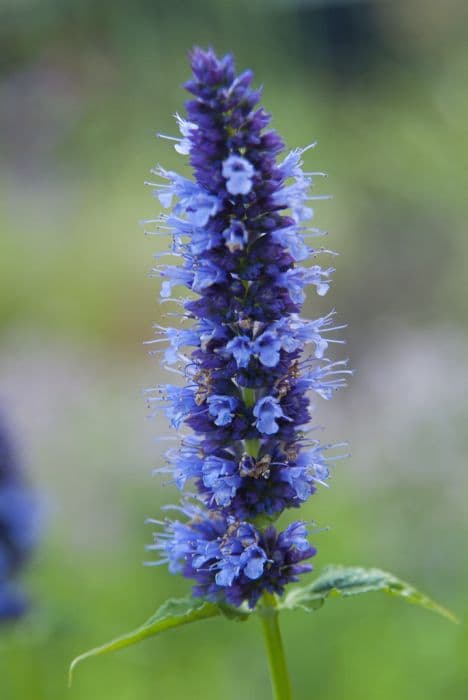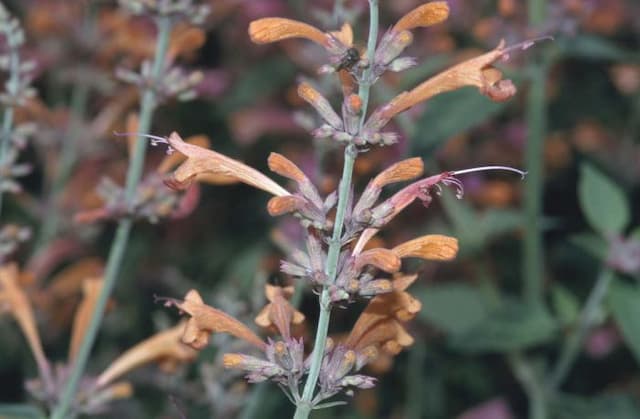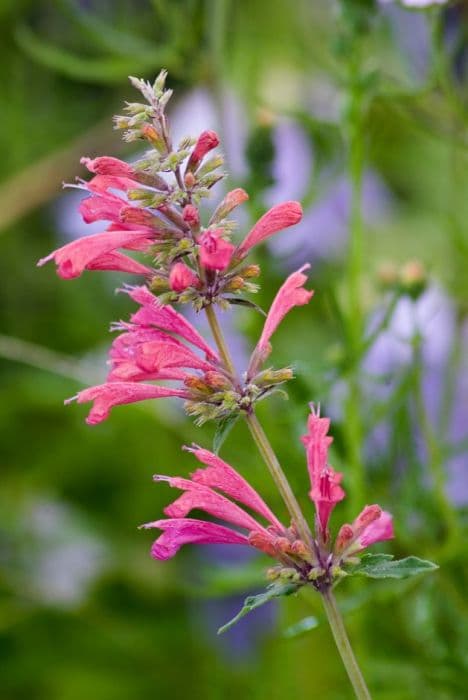Himalayan Mint Bush Colquhounia coccinea

ABOUT
The plant known as Himalayan Mint Shrub is a visually striking specimen with several noteworthy features. It presents a woody stem structure with a rich, vibrant green hue. The leaves exhibit a lanceolate shape and are slightly serrated at the edges, contributing to the plant’s textured appearance. These leaves typically have a lush quality and can possess a subtle sheen. One of the most striking characteristics of the Himalayan Mint Shrub is its vivid flowers which bloom to display a warm, orange-red color. These blossoms are tubular and tend to cluster along the stems, presenting a fiery display that contrasts beautifully against the green foliage. The overall impression of the plant is one of vibrancy and vitality, offering a touch of the exotic to any setting in which it is placed. While the plant makes an ornamental statement with its colorful flowers and lush foliage, it also emits a pleasant aroma which can be particularly refreshing in a garden setting. The combination of visual and olfactory qualities makes the Himalayan Mint Shrub a desirable plant for gardeners and plant enthusiasts who wish to add a sensory-rich plant to their collection.
About this plant
 Names
NamesFamily
Lamiaceae.
Synonyms
Himalayan Mint Shrub, Scarlet Colquhounia.
Common names
Colquhounia coccinea var. mollis, Colquhounia mollis.
 Toxicity
ToxicityTo humans
Colquhounia coccinea, commonly known as Himalayan Mint, does not have a widely recognized reputation for being toxic to humans. There is limited information on its toxicity; however, as with any plant, caution should be exercised, and it should not be consumed unless proven safe. If you suspect poisoning from any plant, seek medical attention immediately.
To pets
Himalayan Mint does not have a specific profile for toxicity in pets such as dogs and cats; however, due to the lack of comprehensive toxicity data, it is recommended to prevent your pets from ingesting this or any unknown plants. If you suspect your pet has ingested Himalayan Mint and is showing symptoms of poisoning, consult your veterinarian promptly.
 Characteristics
CharacteristicsLife cycle
Perennials
Foliage type
Deciduous
Color of leaves
Green
Flower color
Orange
Height
3-4 feet (0.9-1.2 meters)
Spread
2-3 feet (0.6-0.9 meters)
Plant type
Shrub
Hardiness zones
8
Native area
Himalayas
Benefits
 General Benefits
General Benefits- Aesthetic appeal: Colquhounia coccinea, commonly known as Himalayan Mint, has vibrant orange-red flowers that can add a splash of color and visual interest to gardens or landscapes.
- Habitat for wildlife: The flowers of the Himalayan Mint can attract pollinators such as bees and butterflies, therefore providing a habitat and food source for these beneficial insects.
- Erosion control: Himalayan Mint can be used in landscaping to prevent soil erosion due to its shrubby growth habit that can help stabilize the soil.
- Fragrant foliage: The leaves of the Himalayan Mint emit a pleasant mint-like aroma when crushed or brushed against, providing a sensory benefit to gardens or pathways where it's planted.
 Medical Properties
Medical Properties- Antipyretic: Himalayan Mint plant (Colquhounia coccinea) has properties that are believed to reduce fever.
- Analgesic: The plant may be used in traditional medicine to relieve pain.
- Anti-inflammatory: Compounds within the plant might possess properties that help reduce inflammation.
- Antimicrobial: There is a possibility that the plant has antimicrobial properties that can help in fighting certain bacteria or fungi.
 Air-purifying Qualities
Air-purifying QualitiesThis plant is not specifically known for air purifying qualities.
 Other Uses
Other Uses- Himalayan Mint Shrub's woody stems can be used in rural constructions for making temporary supports and frameworks due to their flexible yet sturdy nature.
- The leaves of Himalayan Mint Shrub contain essential oils that can be used in perfumery and aromatherapy to impart a unique fragrance.
- Dried leaves of the plant may serve as a natural insect repellent when burnt, due to the presence of aromatic compounds.
- Fibers from the Himalayan Mint Shrub can be used in the crafting of small ropes and twines for gardening purposes.
- When plant material is abundant, it can be used as a green manure or composting material to enrich soil fertility.
- Flower extracts from the Himalayan Mint Shrub can be used as a natural dye for textiles, yielding various shades depending on the mordant.
- The vibrant flowers can be used in decorative arrangements or potpourri for their aesthetic appeal and fragrance.
- Leaves can be used to infuse oil, creating a scented oil that could be used for massages or in making candles.
- Crushed leaves might serve as a natural polish for wooden furniture, imparting a mild sheen and a pleasant aroma.
- Can be planted as a hedge or ornamental plant to provide structure and color to garden landscapes.
Interesting Facts
 Feng Shui
Feng ShuiThe Himalayan mint is not used in Feng Shui practice.
 Zodiac Sign Compitability
Zodiac Sign CompitabilityThe Himalayan mint is not used in astrology practice.
 Plant Symbolism
Plant Symbolism- Passion and Vitality: The vibrant red flowers of Himalayan Mint (Colquhounia coccinea) symbolize intense emotion and life force.
- Exotic Beauty: Originating from the Himalayas, its exotic appearance lends it the symbolism of uniqueness and striking beauty.
- Warmth: Its warm-colored flowers can represent hospitality and a welcoming environment.
- Resilience: As a plant that thrives in mountainous regions, it often symbolizes the ability to endure and prosper in difficult conditions.
 Water
WaterHimalayan Mint plants should be watered deeply but infrequently, allowing the soil to slightly dry out between waterings. In general, watering once a week with about 1-2 gallons per plant should suffice, depending on the size and maturity of the plant as well as the climate conditions. During the peak of summer or in particularly hot and dry climates, the frequency may increase to twice a week. It is important not to overwater, as this can lead to root rot. Ensure that the plant has good drainage to prevent excess water from accumulating around the roots.
 Light
LightHimalayan Mint thrives in full sun to partial shade conditions. The best spot for this plant would be a location where it receives at least 6 hours of direct sunlight daily, but is protected from the harsh afternoon sun, which can sometimes be too intense. A spot with morning sunlight and afternoon shade would be ideal for striking the perfect balance.
 Temperature
TemperatureHimalayan Mint prefers a warm climate and should be grown in an area where temperatures consistently stay between 60°F and 80°F. They can survive minimum temperatures down to about 50°F but should be protected from frost. The ideal temperature range for promoting the best growth and flowering is between 70°F and 75°F.
 Pruning
PruningPruning Himalayan Mint is essential to maintain its shape and encourage bushier growth. Prune in the late winter or early spring before new growth begins. Remove any dead or damaged stems and thin out overcrowded areas to improve air circulation. Pruning can be done annually or biannually, depending on the plant's growth rate and the desired shape.
 Cleaning
CleaningAs needed
 Soil
SoilThe Himalayan Mint Shrub (Colquhounia coccinea) thrives best in a well-draining soil mix with high organic content, such as a blend of loam, peat, and perlite or sand. It is important for the pH to be mildly acidic to neutral, ideally between 6.0 and 7.0. Amend the soil with compost to enhance its structure and fertility.
 Repotting
RepottingHimalayan Mint Shrub should be repotted every 2-3 years to refresh the soil and accommodate its growth. Choose a pot that is slightly larger than the current one and ensure it has good drainage.
 Humidity & Misting
Humidity & MistingHimalayan Mint Shrub prefers a humidity level between 40-60%, which encourages healthy growth without being too excessive. Avoid placing it in overly dry environments, and use a humidifier if needed to maintain the right humidity level.
 Suitable locations
Suitable locationsIndoor
Grow in bright, indirect light with good air circulation.
Outdoor
Plant in a sheltered spot, partial sun, well-draining soil.
Hardiness zone
8-10 USDA
 Life cycle
Life cycleColquhounia coccinea, commonly known as Himalayan mint shrub, begins its life cycle as a seed that germinates in well-draining soil with sufficient warmth and light. After sprouting, it enters the seedling stage where it develops its first true leaves and begins photosynthesis. As it matures, the Himalayan mint shrub enters the vegetative stage, growing more leaves and stems and establishing a strong root system. It then enters the flowering stage, producing vivid red-orange tubular flowers that are attractive to pollinators, which is followed by fruiting where the plant develops seed capsules containing seeds for the next generation. After pollination and seed set, the plant may experience a period of dormancy, especially in cooler climates, where it conserves energy before beginning the cycle anew. The Himalayan mint shrub is a perennial, and this cycle of vegetative growth and flowering can occur annually for several years.
 Propogation
PropogationPropogation time
Spring to early summer
Propogation: The Himalayan Mint Shrub, Colquhounia coccinea, is often propagated through semi-hardwood cuttings, a method well-suited to this species. This process typically occurs during the late summer to early fall when the new growth has partially matured and woodier but is still flexible. To propagate by cuttings, select healthy, disease-free stems and cut segments approximately 4 to 6 inches (approximately 10 to 15 centimeters) long. It's important to make the cut right below a leaf node and remove the lower leaves, leaving just a few at the top. The cuttings are then dipped in rooting hormone powder to encourage root development and planted in a mixture of peat and perlite to strike roots. They are kept under high humidity and indirect light until roots develop, after which they can be gradually acclimated to less humidity and eventually transplanted.






![Bugle [Sugar Plum]](/_next/image?url=https%3A%2F%2Fplants-admin.emdemapps.com%2Fimages%2Fplants%2F%2Fimages%2F604b597956a55.png&w=640&q=75)
![Bugle [Princess Nadia]](/_next/image?url=https%3A%2F%2Fplants-admin.emdemapps.com%2Fimages%2Fplants%2F%2Fimages%2F604b5806e268c.png&w=640&q=75)

